Lenovo ThinkCentre M90n-IoT Internal
The bottom cover is secured with two screws, and then it slides off. This is very easy to service and you can see the cover being removed in the accompanying video.
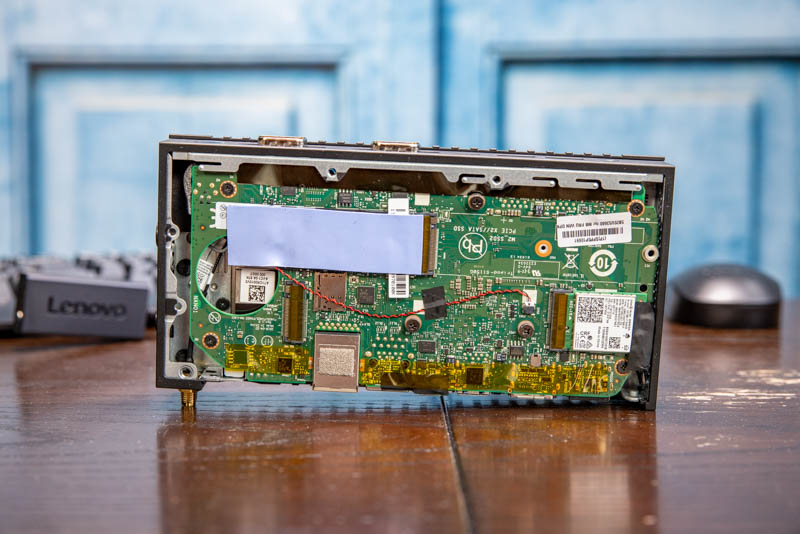
On the left side of the PCB, we get a large thermal pad for the Samsung NVMe SSD. We can also see a Realtek RTL8111 NIC just below that area and above the red/black wire.
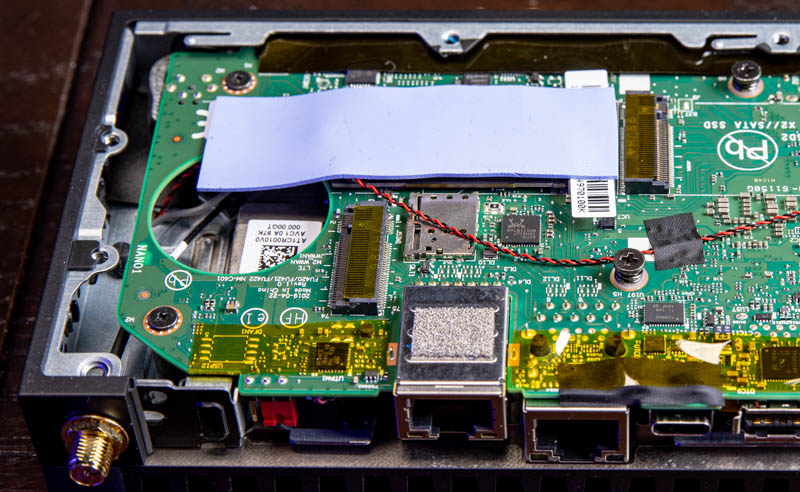
This system has a feature many may not expect in that it has a second M.2 mounting point for a second SSD. This is a PCIe Gen3 x2 slot for NVMe SSDs or a M.2 SATA slot adding a nice bit of extra expandability.
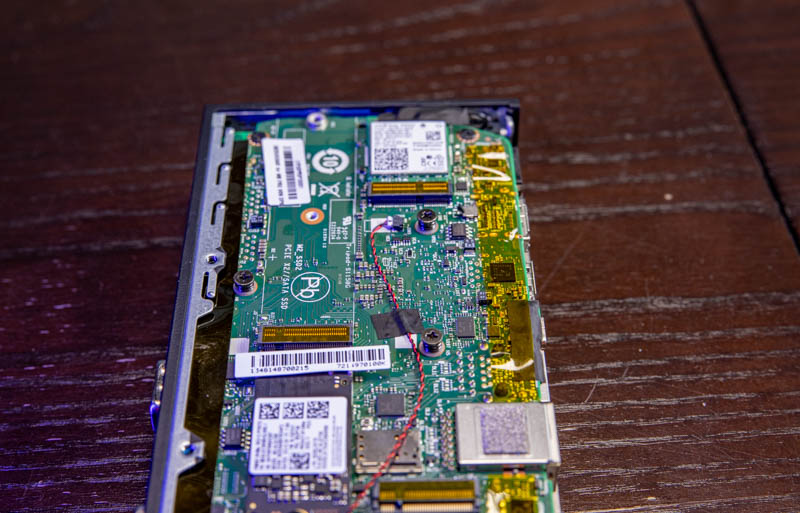
We can also see the Intel 9560NGW 802.11ac and Bluetooth 5.1 card that provides wireless access. Technically, this unit has three NICs, two wired, and one wireless.
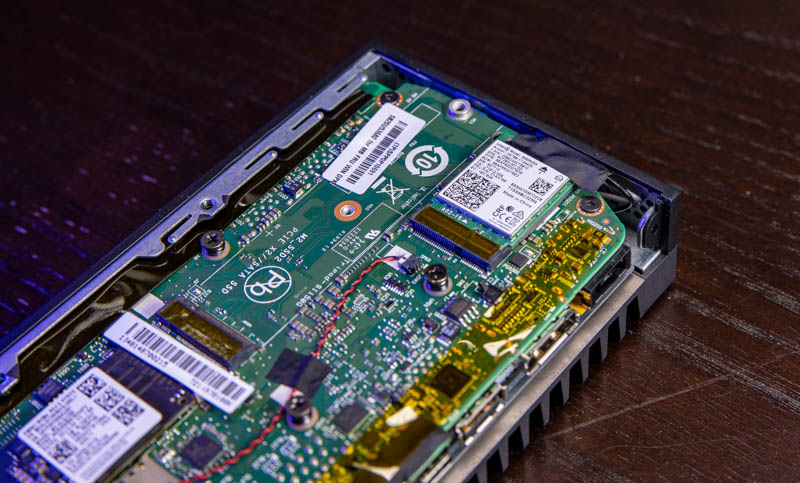
On the other end of the unit, we get some interesting components next to the M.2 SSD. One can see a large hole in the motherboard PCB. In the non-IoT version there is a fan here, but in this passively cooled system that is omitted.
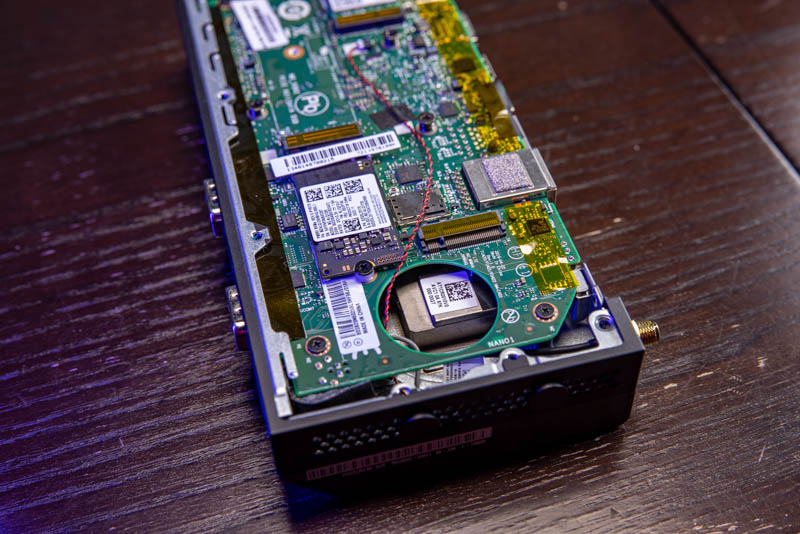
Perhaps the biggest feature is that we get a M.2 slot that is labeled “LTE” and WWAN. This is a slot designed to house a LTE card for wireless WAN access. Just above that slot, we see the SIM card slot. This unpopulated set of WWAN slots is next to the side ports that are meant to house antennas on the side of this chassis.
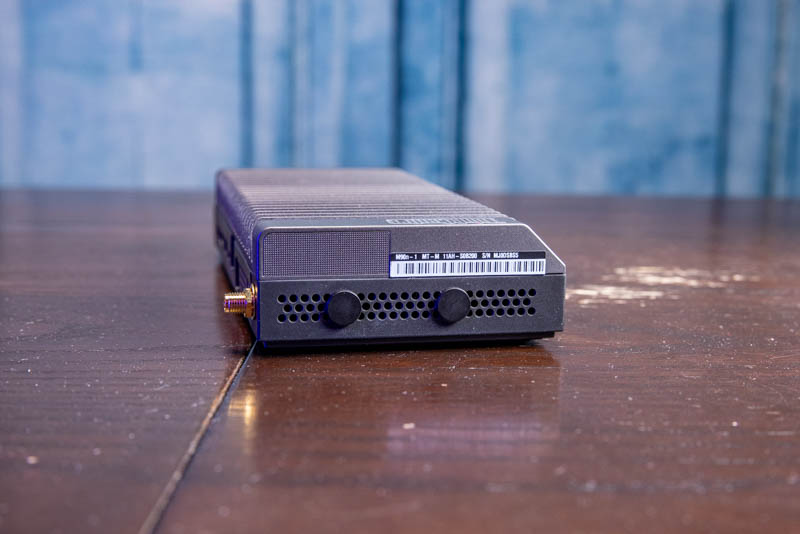
Perhaps the biggest negative is that the system does not have a strong CPU. This system comes with an ultra-low-power Intel Core i3-8145U. This is a dual-core, four-thread processor. Lenovo had to go with a low power option to passively cool the system.
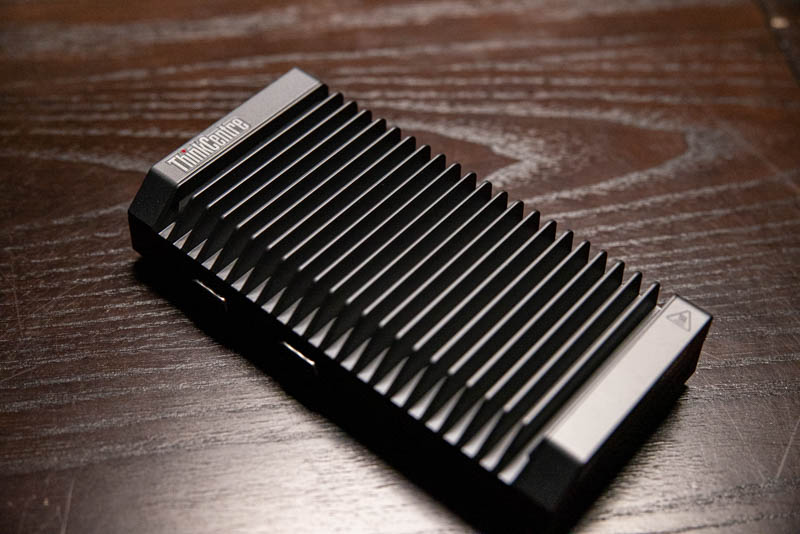
Another major downside to the platform is the RAM. There is only a total of 4GB of memory in this system. That memory is not in a standard SODIMM slot. Instead, it is soldered onto the motherboard making easy upgrades effectively impossible. This is perhaps the biggest shortcoming of this system over a TinyMiniMicro node. If it had even a single SODIMM slot where memory could be installed, that would make a big difference. It is also a primary reason why this and the M90n Nano (non-IoT) we do not recommend as virtualization nodes except in very limited use cases. Project TinyMiniMicro nodes have faster CPUs and the capacity to get to higher RAM levels making them usually the better solution unless fanless operation and space are the primary drivers.
One benefit of this is ultra-low power consumption. At idle, this unit rivals the BMCs found on many Atom-based server motherboards when the server is powered off. As a trade-off, we do not get IPMI access.
Use Cases: The Good and Bad
First, the addition of COM ports means that this has a market. The Project TinyMiniMicro nodes often have COM ports, but this is a lower-power fan-less option if you just need serial ports for data collection/ processing or even just to serve as console access to devices. A great use case is ingesting data from a sensor and parsing/ compressing logs directly on this device to limit the amount of data that needs to be uploaded.
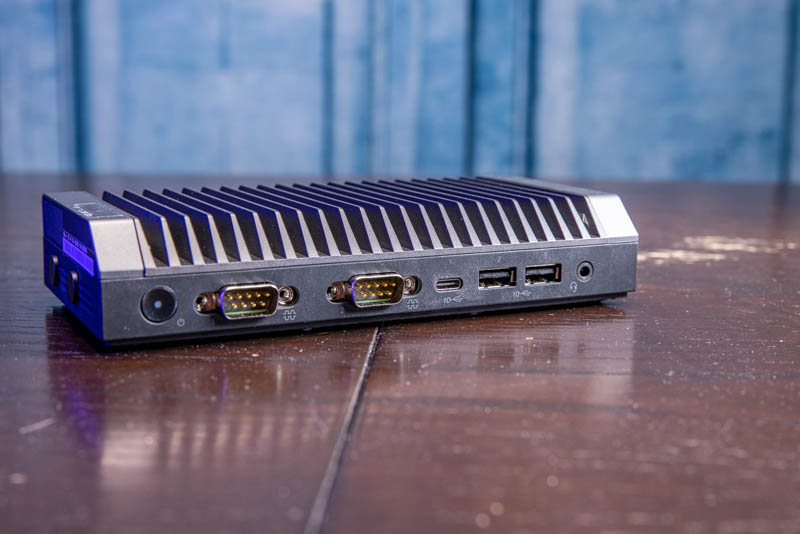
The dual 1GbE NICs also make this potentially suitable as a firewall appliance. While there are less expensive options on the market using Atom chips, this has a higher-end CPU and is also sold by Lenovo with an on-site warranty. These are Realtek NICs, but we get asked about dual NICs in the Project TInyMiniMicro segment, so we think it is an important point.
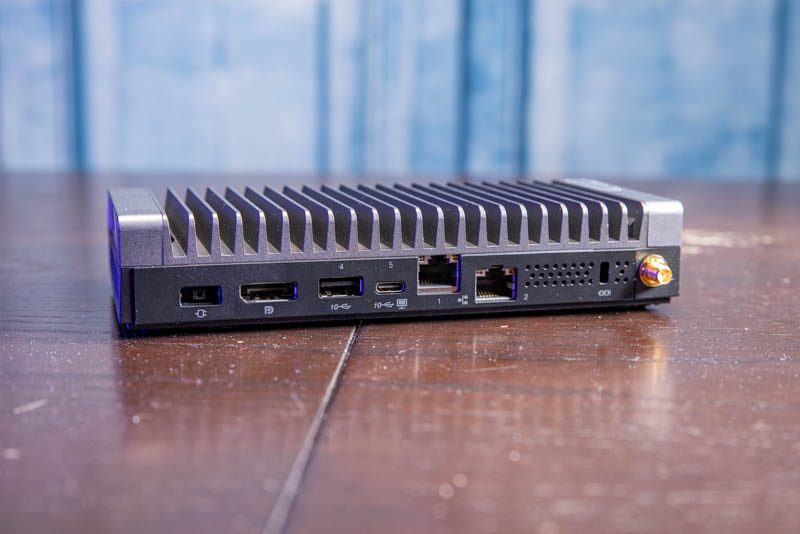
The second SSD slot adds some functionality, but this is probably not the ideal NAS solution. Likewise, as a desktop, having the included Windows 10 Home license is great, but it is a slow dual-core processor with 4GB of memory so it is far from an ideal modern desktop experience. Our sense is that most will use this as an IoT node instead of as a primary desktop.
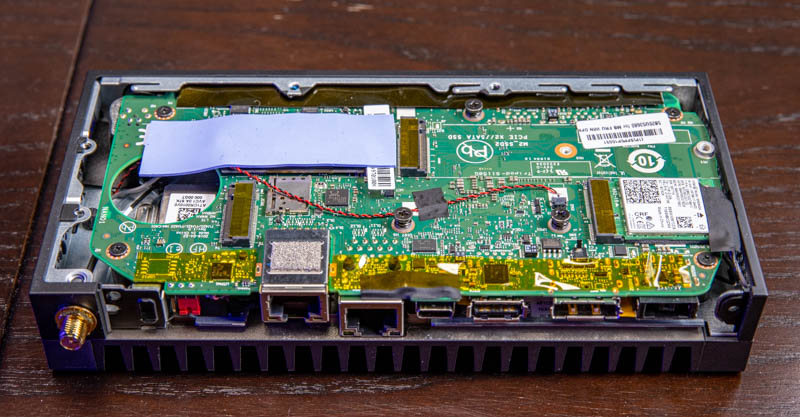
The appeal of this unit is clearly the passive chassis and relatively solid set of features. We can forgive many of the shortcomings of the system due to this design, along with the price.
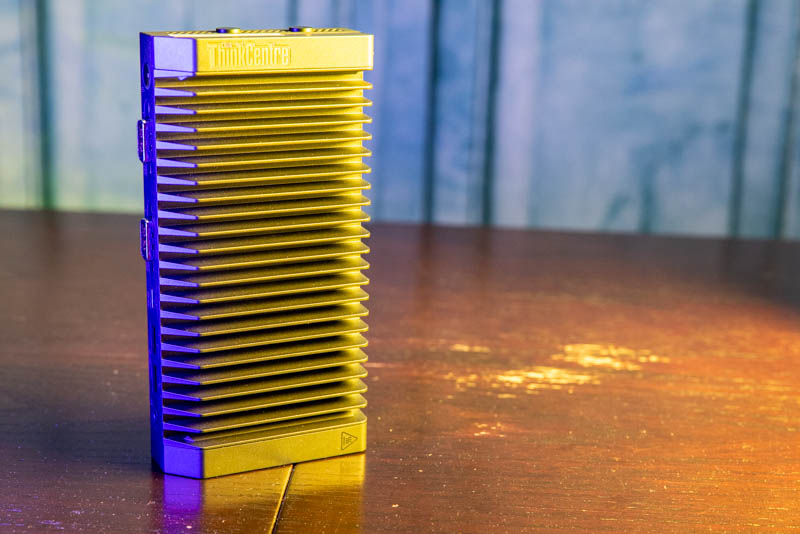
In a few of these photos, as well as in the video, you will see we had the non-IoT Lenovo M90n Nano. To us, that is a better desktop experience, but the use cases as a server node are a bit harder for us to justify. Unless space is at an extreme premium, moving up to the Project TinyMiniMicro 1L form factor makes a lot of sense since one can effectively have nodes that have 2-8x the CPU performance and memory capacity (our non-IoT version has 8GB of memory.) Effectively, one needs a cluster of the non-IoT Nanos to equal a TinyMiniMicro 1L node making the TMM nodes a much better fit unless there is an extremely narrow use case.
Final Words
Overall, this is an interesting little system that is frankly made more interesting based on the pricing. At $800 this would be a tough sell. At $419 when we reviewed the 256GB version last year, it was a decent option. At $200 new from Lenovo, this appeals to a completely new set of users. Hopefully, that was not just an end-of-year deal.
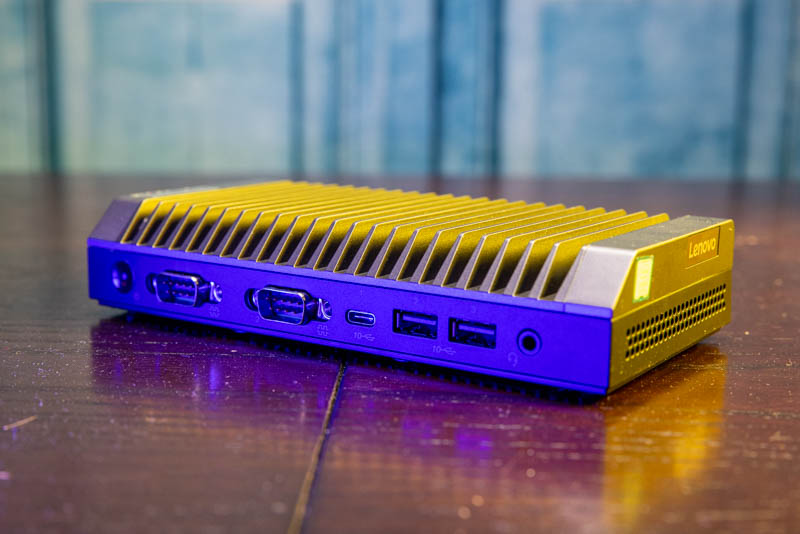
We have gotten many questions on this and the non-IoT version as part of our TinyMiniMicro series. We generally consider these as a different segment due to different feature sets and limitations of the smaller form factors. We hope this piece both answers some of those questions while providing a view of the segment from a TinyMiniMicro perspective.

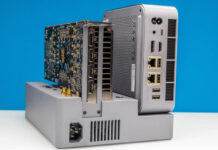


If only it had 8GB & Intel NICs for $250 ;)
There’s just enough RAM for hyper-v server, pfsense, and a file server. Bought one when they went on sale.
Using it at home for my router.
But OMG if this had 8GB RAM and Intel Nic!!! Yes please!!
Realtek nics makes this not good for pfsense. Too bad.
@Griffin and @SF
This is quite good:
https://www.seeedstudio.com/ODYSSEY-X86J4105864-p-4447.html
Why the fuss about a „weak“ CPU and „only“ 4 GB RAM? These devices typically function as sensor platforms for example. My company uses hundreds of these type of „industrial“ PC‘s to collect data from temperature and moisture sensors etc. and forward the data to a centra datacentre. For that, such CPU‘s and RAM are more than adequate. These are Edge devices after all and Linux uses very little resources. Running a desktop on this, is just plain silly.
Sometimes I get the feeling that the STH crew wants to run hypervisors on everything, where CPU and Memory are more important.
@Dave – you do know the title of the website? “serve THE HOME” – thats the entire idea. how we can get enterprise technology trickle down in size for use in homes. Not just by using old powerhungry servers. – Many homes are space limited, now i would agree that running a type 1 hypervisor on that m90n iot would be not so ideal. It is actually interesting to see how far we can go in size. I seriosly loved the Helmer Cluster – which was a blender Renderfarm in an Ikea Helmer Cabinet. A bunch of these – maybe a bit more powerful, and we could do the same cluster in 1 drawer of the cabinet :-)
Default of pfsense 2.5 devel gave terrible results of about 25mb on a gig line when running speedtest. Returning to my 720q w/ quad intel nic gives the 950mb i want.
I’ve heard others say that realtek can be improved with drivers, but that’s not an easy step for me, nor did they seem included with the latest nightly build of pfsense.
This is an IoT device, not a desktop replacement. Should be tested like one. When the price was lowered it put it with the various Pi/Odroid/Geekworm type setups. No upgradable RAM, etc. I have both the M90n and the M75n IoT models. I added a CAT9 LTE card to give it another WAN type. The M90n is great little device with the i3. The AMD M75 has a stripped down 6W Ryzen which is even cheaper than the M90. But its performance is much lower and closer to the ARM boards. Very easy to take apart. Very easy to change out the SSD’s, the WiFi or the WWAN. All accessible by removing the top cover. If you have hang ups about Realtek or memory expansion, look in a different price point.
Where is the power consumption of this unit? That’s what I want to know.
John, just plugged mine into a Kill-a-Watt, highest peak power I saw was on boot at about 17W for just a moment.
Pfsense at ‘idle’ is around 5 to 6W, it seems to go up and down by about 1W. I do have Two NVMe’s installed in this unit and that may slightly increase the power draw.
While doing a fast.com speed test the power went up to about 11W. This is a pretty standard dev pfSense 2.5 single LAN configuration, also added pfBlocker, just to see if I could get the CPU to do something while updating the blocker database. (It didn’t seem to go above 10W)
I used the updated Realtek drivers by dropping to the shell and doing “pkg install realtek-re-kmod” then following the instructions that are there to modify one file.
Sorry, I forgot to mention this was with a gigabit fibre which is almost symmetrical. Speeds of 970Mbps down and 950Mbps yo are normal bandwidth for me with my GPON fibre during the day.
The dual serial, wwan port and passive cooling would make this amazing for light industrial control/monitoring.